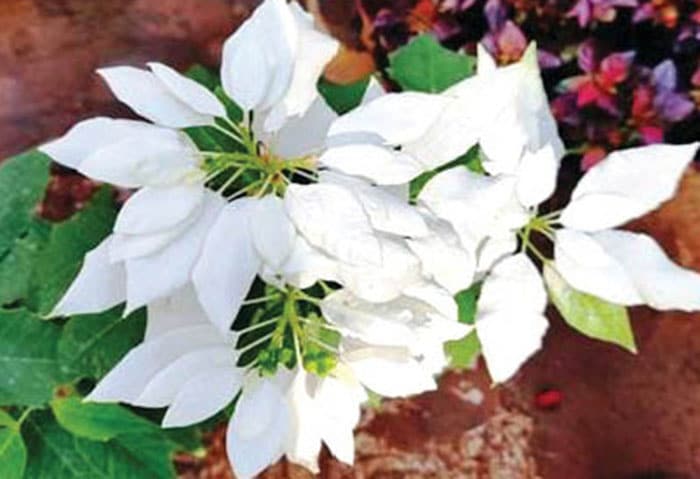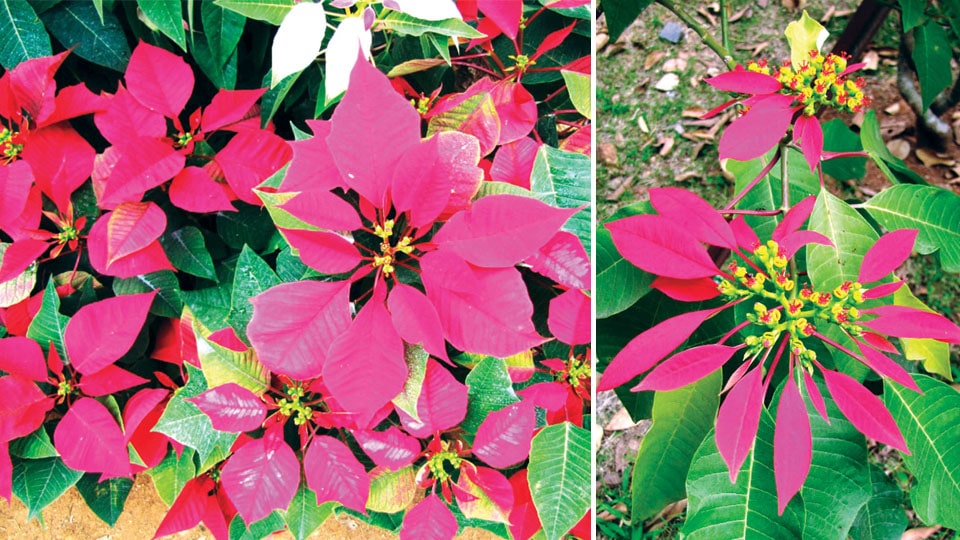Text & photographs by Dr. Mahadeswara Swamy, Scientist
Florals and foliage of several species of ornamental plants are associated with the festive season of Christmas. Apart from the well known, rather celebrated, ‘Christmas tree’ a wide variety of plants embrace “Christmas” in their common names e.g. Poinsettia, Holly, Mistletoe, Ivy, Christmas Cactus, Christmas Bells, Christmas Roses (Helleborus ssp, Hydrangea sps), “Snow Rose” or “Winter Rose” (Serissa foetida). Together they are called ‘Christmas plants.’ Another common term used for these herbals in western countries (America and Europe) is ‘Holiday plants.’* Among these, ‘Poinsettia’ is the most admired. It is next only to ‘Christmas Tree’ in popularity. With brilliant red floral display held against rich green foliage it is adorable with its appealing presentation of the traditional Christmas colours. It’s relationship to Christmas dates back to 16th-century. According to a Mexican legend a poor little girl (Pepita or Maria ?) was very much worried as she had no gift to celebrate Lord Jesus’s birthday; during which time, an angel asked her to offer any gift with love. The young girl collected handful of weed plants growing on the road side and placed them in the manger (a makeshift crib for the Baby Jesus — a Christian symbol). Miraculously, the weeds blossomed into beautiful red stars, the present day ‘Poinsettias.’ Thus, the plant became legendary. Being popular they are sold everywhere from florists and nurseries to supermarkets and convenience stores all around the world. Infact, ‘Poinsettia’ trade is a multi-million dollar business in the US and Europe.
It’s common English name ‘Poinsettia’ is in honour of Joel Roberts Poinsett, the first United States Minister to Mexico, who introduced the plant to the US in 1825. The plant is also known as ‘Christmas Star,’ ‘Christmas Flower,’ ‘Crown of the Andes,’ ‘Painted Leaf,’ ‘Mexican Flame Tree,’ ‘Lobster Plant’ and ‘Lalpata in Hindi.’ It’s scientific name is Euphorbia Pulcherrima (syn. Poinsettia Pulcherrima) belonging to the family Euphorbiaceae. The generic name ‘Euphorbia’ is derived from Euphorbos, the Greek physician of King Luba (or Juba) II of Numidia (52–50 BC – 23 AD), who married the daughter of Anthony and Cleopatra; species epithet ‘Pulcherrima’ means “very beautiful.”
Euphorbia Pulcherima is a native to tropical Central America and Mexico. It is a shrub with smooth green erect stems, growing upto10 ft. When cut, a milky sap oozes out from the stem. The leaves are green, large, oval shaped and dentate (“toothed” margins) on the sides and pointed at the tips. Flowers are borne at the stem tips. The floral arrangement is quite different from the typical floral plan and the flowers appear inside a small cup-shaped structure called Cyathium (or Cyathia) at the centre of the brilliantly coloured “bracts” (bracts are actually modified leaves). Each Cyathia, yellow in colour, contains unisexual, apetalous (without petals) flowers. The inconspicuous male flowers occur in clusters and are reduced to a single red stamen, while the female ones consists of a single ovary (pistil) hidden within the cyathium. The rim of the cyathium bears nectar glands which are attractive to insect pollinators. Fruits are called capsules with ovoid shaped pale grey seeds.
There are many cultivars (varieties). A few notable among them are: ‘Silver Star’ — dusky pink bracts and variegated leaves; ‘Lemon Snow’ — pale yellow bracts; ‘Cortez Burgundy’ — deep plum bracts; ‘Jingle Bells’ — red, pink flecks; ‘Darlyne Pink’ — reddish pink bracts and ‘White Splendor’ — white bracts.
Holiday plants
The Christmas season is also called the ‘Holiday Season’ or the ‘Festive Season,’ an annual recurring period from late November to early January as recognised in many Western and other countries. Plants used for winter festivities during this season are called ‘Holiday plants.’

Useful tips
- Poinsettias are winter blooming perennials.
- They can be easily grown in flower beds, pots or containers.
- Beautiful additions to any type of garden or parks.
- They prefer diffused light and moderate watering.
- Over watering may result in grey mould attack.
- Prune the plants in June for best floral display during winter.
- Transfer the plants to sunny places during winter for best colour development .
- Poinsettias can be propagated easily by softwood cuttings .
- Common pests like scale insect and mealy-bug may attack and can be easily controlled by applying pesticides.
- Most of the present day Poinsettias sold during winter are dwarf varieties. They are the right choice for indoor decoration and floral bouquets during winter festivities. They are also best eco-friendly gifts for any occasion.
- The plants brought for Christmas are often disposed off after the festivity as they start fading especially when placed indoors. But with a little care, one can keep them throughout the year. Keep the plants outside in semi shade areas. The plants recover and bracts brighten up (colour up) again during the next season.
Caution
Toxic compounds are found in the milky latex, but they are of low toxicity. If ingested it induces abdominal pain with vomiting and diarrhoea. Frequent contact with skin may cause redness, swelling and blisters lasting for a few minutes.
Where to see
Home gardens and public parks; Sold in plant nurseries during Christmas season.
Mob: 97429-91057 / e-mail: [email protected]








Recent Comments